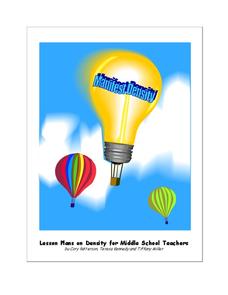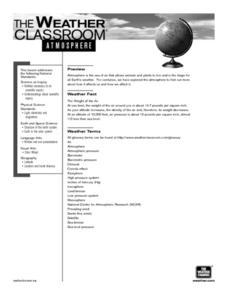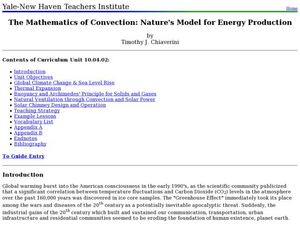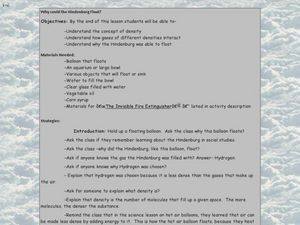Curated OER
Hot Air Balloon Design Lesson Plan
Sixth graders discuss what they know and what they want to know about hot air balloon using a KWL chart. They then use a wide array of materials to design a hot air balloon that will lift successfully in cooperative groups referring to...
Curated OER
Activity 1 Up, Up, and Away: Building a Hot Air Balloon
Learners investigate the question: "How does a hot air balloon work?" They build small hot air balloons ans then lauch them. Students discuss how they think a hot air balloon floats. Pupils are introduced to the use of models as a...
Curated OER
Hot Air Balloons
Students examine how a hot air balloon works. In this hot air balloon instructional activity, students do an experiment to test the effects of heat on density. Students make their own hot air balloon and act out how nitrogen moves when...
Curated OER
Hot air Balloons
Learners study how hot air balloons were created and the different types there are. In this density and lift lesson students build their own hot air balloon.
Curated OER
Float a Hot Air Balloon
This activity will lift spirits in your class, but there is little scientific explanation for what makes a hot air balloon rise. As you are teaching middle school scientists about density and convection, you can incorporate this...
Curated OER
Hot Air Balloon
Students view a video and discuss the mechanics of a hot air balloon. They, in groups, construct a functioning hot air balloon.
University of Southern Indiana
Manifest Density
There's a lot content packed into the four lessons of this physical science unit on density. From salad dressing to the water cycle and hot air balloons, these lessons engage students in hands-on activities that explore real-world...
Curated OER
Bag Balloons
Young scholars demonstrate that heat can change air. They determine that hot air rises. Students construct a working model of a hot air balloon. They understand that there are two ways that a balloon can rise: it can (1) be filled...
Curated OER
THE TRAVELS OF BABAR: An Adventure in Scale :Building a Model Hot Air Balloon
Students encounter basic facts about helium and hot air. They compare the weight and size of different materials. Students work collaboratively in teams. They create their own model balloon.
Colorado State University
Can Gravity Push Something Up?
How does a hot air balloon fly? An experimental lesson has scholars build a balloon from a garbage bag and monitor the movement of air. As the temperature of the air in the balloon increases, gravity moves the denser cool air down,...
Colorado State University
If Hot Air Rises, Why Is it Cold in the Mountains?
Investigate the relationship between temperature and pressure. Learners change the pressure of a sample of air and monitor its temperature. They learn that as air decreases its pressure, its thermal energy converts to kinetic energy.
Curated OER
Balloons
Learners explore the different types of balloons. In this materials lesson students can complete several experiments including building their own hot air balloons, making balloon animals and experimenting with static electricity.
Curated OER
Full of Hot Air
Students investigate technology and its many designs to make our lives easy. In this science lesson, students build a hot air balloon and answer specific questions about weight and rides in the hot air balloon. They analyze their data...
Curated OER
Warm and Cold Air
Students conduct an experiment to discover what happens to air when it is heated or cooled, discover that wind moves from a high-pressure area (an area of sinking air) to a low pressure area (an area of rising air).
Curated OER
Are You Full of Hot Air?
Explore the concept of measuring and recording circumference. In this physical science and measurement lesson plan, young learners blow up balloons, measure the circumference, and record the data on an interactive graphing website.
Curated OER
The Weather Classroom - Atmosphere
Meteorology learners explore the weight of air, layers of the atmosphere, and air pressure action through a series of discussions, demonstrations, and hands-on group activities. Enough discussion prompts, background information, student...
Curated OER
The Mathematics of Convection: Nature's Model for Energy Production
High schoolers conduct a series of experiments to investigate density, buoyancy and climate. In this math lesson, pupils design and build a hot air balloon to demonstrate convection. They research and write a paper about solar chimneys.
Curated OER
Air Is All Around Us!
Students design an instrument to show that air is all around. In this air lesson plan, students research, construct, and present a design that proves that air is all around, even though they can't see it or touch it. A teacher and self...
Curated OER
Air Density and Temperature
Students investigate the effect of temperature on the density of air by putting an uncovered bottle in a bucket of hot water. Then they place a balloon over the mouth of the bottle. They repeat the procedure using ice water and explain...
Alabama Learning Exchange
Float or Sink?
Experiment with mass and density as scholars figure out what makes things float or sink. First, they watch a podcast introducing these concepts. Be sure to use the comprehension question to test their understanding. Young scientists...
Curated OER
Warm Air versus Cold Air
Students discover that warm air takes up more space than cold air. In this science lesson, students perform 4 experiments using balloons to determine that the molecules of warm air are more spread out than those of cold air.
Curated OER
The Properties of Air
First graders draw conclusions about the properties of air. In this properties of air lesson, the teacher demonstrates several properties of air and guides students through discovering that air is colorless, tasteless, odorless, exerts...
Curated OER
Convection in a Pan
Students watch a demonstration using a plastic bag and a hair dryer to create a hot air balloon. After the demonstration, they discuss the results and whether or not hot water behaves the in the same manner as hot air. They conduct...
Curated OER
Why Could the Hindenburg Float?
Tenth graders experiment with floating and sinking objects and heavy and light liquids, using correct terms, like density, to explain what happens. In this Hindenburg instructional activity, 10th graders watch a demonstration called the...
Other popular searches
- Art Hot Air Balloons
- Hot Air Balloon Patterns
- Hot Air Balloon Rides
- Hot Air Balloon Image
- Tissue Hot Air Balloon
- First Hot Air Balloon
- Innovation Hot Air Balloons
- Hot Air Balloon Art
- Hot Air Balloons Preschools
- Early Hot Air Balloon
- Hot Air Balloon Integers
- Hot Air Balloon Video

























